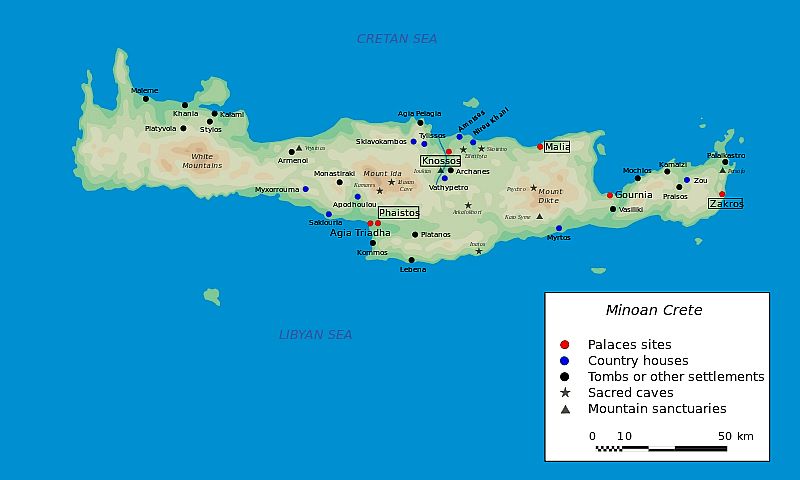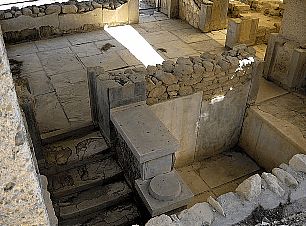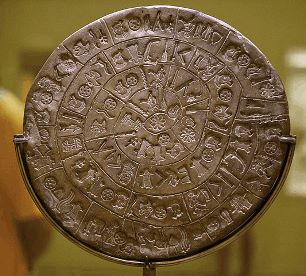The Phaistos Disc
Puzzle of Crete

|
Ancient Crete has been a source of a few language puzzles. In the palace of Knossos, three different writing systems were discovered, in the forms of a hieroglyphic script, Linear A, and Linear B (see Parrot Time issue two for Linear A - Lost Minoan). But they weren't the only mysteries found. A single disc containing an unknown writing system was also found in the ruins of the nearby palace of Phaistos. This circular clay disc, covered with inscribed symbols on both sides which are unlike any signs in any known writing system, became known as the Phaistos Disc, and to this day, remains undeciphered. Discovery The symbols themselves resemble common objects. These include human figures and body parts, weapons, fish, birds, insects, plants, a boat, a shield and a staff. Phaistos was an ancient city near Hagia Triada on the south coast of Crete, dating perhaps as far back as 6000 BC. The city rose up from the fertile plains of the Messara region and became part of the growing Minoan empire. The first Minoan palace of Phaistos was built around 2000 BC, about the same time as the main palace of the empire was built in Knossos. Both of these Palaces were destroyed by a strong earthquake in 1700 BC and rebuilt on top of the old ones. The earthquake was caused by a volcano erupting on the nearby island of Thera (modern day Santorini). The palace of Phaistos was destroyed a few centuries later, and again, rebuilt. Around 1400 BC, Crete was invaded by the Achaeans of Greece and both cities of Phaistos and Knossos were destroyed. The Phaistos palace seems to have been abandoned after that, but the city itself was rebuilt and thrived for a few more centuries, even minting its own coins. However, the city was finally destroyed in the first century BC by the neighboring city of Gortyn.  Map of Crete, showing both Knossos and Phaistos During the Minoan empire, Phaistos became a major city-state, with its power stretching from Lithinon to Psychion, including the Paximadia islands, during its peak. It was a participant in the Trojan war, as recorded by the Greek poet Homer, and had two ports, Matala and Kommos. The palace controlled the Messara valley and was the center of the city as well as the administrational and economical center for the area. It was surrounded by luxurious mansions and crowded urban communities. The precise location of Phaistos was first established by British admiral Thomas Abel Brimage Spratt, commander of the Spitfire, a paddle steamer, during the Mediterranean Survey of 1853. The survey was cataloging the topography and settlements of Crete. The location was a ridge, rising from the middle of the Yeropotamos river valley and extending from the sea to the Messara Plain. There was a small village of sixteen houses there, but the remains of some walls showed that a city had once been existed on that spot.  Stairs in the remains of the palace of Phaistos, leading down to a storeroom like where the disc was found An archaeological investigation of the palace started in 1884 by Italian archaeologists Federico Halbherr and Antonio Taramelli. After removing the houses, they began to discover what remained of a large palace complex. They found three distinct construction phases showing the destruction and rebuilding of the palace. From continuous archaeological excavations, the true magnificence of the palace was revealed. It had great royal courts, a theatre, and numerous storerooms, which were used for mainly holding traded goods. The disc was discovered in July, 1908, in the basement of one of the rooms of the palace. Its finder was another Italian archaeologist, Luigi Pernier. The basement was the main room of an underground "temple depository" in which all the rooms were only accessible from above. The contents of the rooms were mostly black earth and ashes, and everything was covered in a layer of plaster dust. The disc wasn't the only item found in the room. Several centimeters from it was a stone tablet containing text written in Linear A. Description  The Phaistos Disc, today on display at the Iraklion Archaeological Museum The disc itself is around 16 centimeters (6.5 inches) in diameter. Both sides of the disc are covered with symbols, arranged in a spiral pattern, going clockwise around into the center. The symbols are similar to hieroglyphs, being more drawings then simple letters. There are 241 of these hieroglyphs on the disc, composed of only forty-five unique ones. They are further grouped together as "words" with vertical lines separating them. Some of these words are recurring, suggesting a refrain of a song or ritual. There are sixty-one of these words. The symbols were imprinted into the disc when the clay was still wet, and the consistency between similar glyphs suggest that they were pressed in using hieroglyphic "seals", or stamps. These would suggest some kind of mass production, although no other such discs have yet been discovered. The symbols themselves resemble common objects. These include human figures and body parts, weapons, fish, birds, insects, plants, a boat, a shield and a staff. Some of the last symbols in a word also have a small diagonal line under them which was scratched on, not pressed in. Translation Attempts Over the years, many amateur and professional archaeologists have made attempts to decipher the code of the disc. It is not necessarily a script, but most attempts have assumed that it is, even going further in believing that it is a syllabary , an alphabet or a logography. The main problem in deciphering is that there is simply not a large enough body of text to analyze. This has left the meaning open to some wildly speculative guesses. Writing Systems Alphabet - set of basic written symbols or graphemes, called letters, in which each letter represents a phoneme (basic significant sound) of the spoken language. Syllabary - set of written symbols that represent the syllables which make up words. Logography - set of written symbols in which each symbol represents a word, morpheme or semantic unit. How the symbols should be viewed is another point of debate. A symbol could be a pictograph, meaning it is translated directly as the object it shows. A symbol that looks like a boat would be translated as "boat". However, it the symbol is an ideogram, it might represent an idea instead. In that case, a boat might mean something like "travel". While it is generally accepted now that the characters should be read from the outside moving clockwise into the center, rather than from the center moving outward, there is not an agreement on how the characters should be displayed when transcribed into text. Because of the clockwise rotation of the text with the bottom of the characters facing out from the center, the text is probably meant to be read right-to-left, like Arabic. This also means that the reading direction is going into the faces of the people and animals, as it is with Anatolian and Egyptian hieroglyphics. This is disputed by the idea that if the text moves clockwise, then it should also should be read left-to-right. Some symbols have been shown to be similar to Linear A characters. Other scholars have pointed to similarities with Anatolian or Egyptian hieroglyphs. However, no matches for all the characters in single set of characters has been found. These similarities, along with the finding of tablets written in Linear A in both palaces, makes these three writing systems the best candidates for providing a solution. Some of the signs are close enough to Linear A and its translated counterpart, Linear B, that some scholars believe they might have the same phonetic values. In his recent book, Der Diskos Von Phaistos (The Phaistos Disc), Torsten Timm declares that the language on the disc is the same as Linear A. However, only 20 of the 45 characters match those found of what is known of Linear A, leaving over half of them still unaccounted for. And even if they are the same, it doesn't truly aid in the decoding, since Linear A itself has yet to be deciphered. Other scholars look at Anatolian hieroglyphics being the key, not just to Linear A but to the Phaistos Disc as well. During the 1960s, a theory evolved that Linear A could be an Anatolian language, close to Luwian, an extinct language of the Anatolian branch of the Indo-European language family. Part of that is the idea that the extra stroke under some of the characters is similar to a symbol used in Luwian. These could then be used to match up with logograms, the basic characters in a logography, found in Luwian. |
| The Phaistos Disc - Puzzle of Crete | ||||||||||||||||||
| Writer: | Lucille Martin | |||||||||||||||||
| Images: | ||||||||||||||||||
| ||||||||||||||||||
| Sources: | ||||||||||||||||||
| ||||||||||||||||||
All images are Copyright - CC BY-SA (Creative Commons Share Alike) by their respective owners, except for Petey, which is Public Domain (PD) or unless otherwise noted.
comments powered by Disqus



















